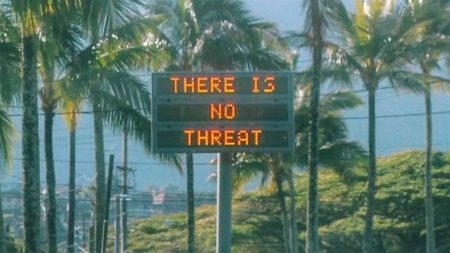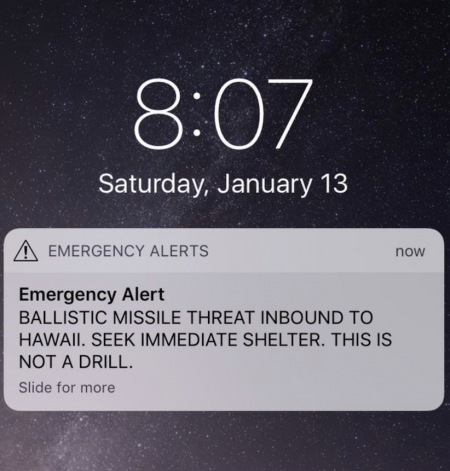
January 14, 2018 – If people in Hawaii on the morning of Saturday, January 13th, didn’t have smartphones, tablets, and computers, no one would have been subjected to a false alert of an impending missile attack sent through the ubiquitous telecommunications network that envelops us today.
Just after sunrise, the message seen in the image above appeared on thousands of screens across the state, one that has a long memory of an attack arising from the Pacific Ocean to the west some 76 years ago. The message said in all caps, which is equivalent to shouting on the Internet, “SEEK IMMEDIATE SHELTER.” On one of the television networks, a college basketball game was interrupted by a series of ominous and continuous beeps followed by a ticker going across the screen stating “A missile may impact land or sea in minutes. This is not a drill.”
The TV announcement provided no advice. The Internet message said seek shelter.
For those on the receiving end, what in heaven’s name did “shelter” mean? How do you shelter yourself from a missile with an atomic warhead?
Remembering Pearl Harbor
The attack on Pearl Harbor on December 7, 1941, caught Hawaii by surprise. It was a weekend morning, a Sunday, not a Saturday. The sun rose on that Sunday in the same beautiful way it did last Saturday. But for the people of Oahu 76 years ago, the Pearl Harbor attack became reality when they looked up at the Japanese fighters and bombers overhead and recognized that these airplanes bore foreign insignia.
There was no warning. There was no advanced radar tracking, no NORAD command center, no telecommunications, computers, and television network to alert them to an impending strike. Few had the time to react, and few were prepared for what ensued.
Saturday’s False Alarm
That 76-year old reality was far different than the one Hawaiians and visitors to the islands faced on Saturday. An entire state received a disembodied Emergency Management Agency announcement which appeared on small and big screens. The range of peoples’ responses varied from disbelief to panic, to prayer. In some hotels, guests were advised to seek shelter in lobbies and basements. The sinister message, telling people to seek shelter, provided little in the way of advice about what was meant by a shelter capable of surviving a thermonuclear attack.
Many believed what they were seeing on their screens. Why? Because in the age of Donald Trump and Kim Jong-un, the world has been witnessing in the news for weeks and months, nuclear brinksmanship, with the latest bombast comparing the size of the two leaders’ nuclear buttons. Suddenly the impossible seemed plausible.
This Week’s CDC Grand Rounds on Nuclear War Preparation
Last week I wrote about the Centers for Disease Control (CDC) intention to live web stream a grand rounds presentation on planning and preparing for nuclear war. It is scheduled for this week on January 16th and will discuss among its many topics, preparing for the unthinkable, response efforts, and radiation preparedness. In the announcement, it began by stating “while a nuclear detonation is unlikely” it is important to put in place “critical protection steps.”
Hawaii has recently updated its practice for notifying the public about missile launches in the face of North Korean missile and atomic bomb tests. It appears those in charge need to improve their processes. And it might be useful to Hawaiians to tune in to the grand rounds CDC event on Tuesday because this may be the only preparation they receive to deal with the perceived threat in the absence of good governance from U.S. leadership.










